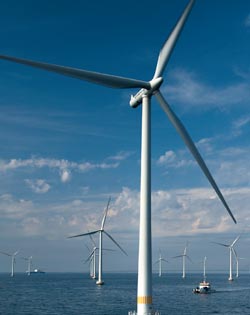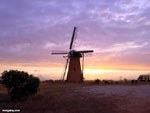The Obama Administration has approved the nation’s first offshore wind farm after more than eight years of legal challenges, reports the Associated Press.
Speaking Wednesday in Boston, U.S. Interior Secretary Ken Salazar said the $2 billion Cape Wind project marks “a new direction in our nation’s energy future.”
The 130-turbine, 420-megawatt wind farm will generate enough electricity to power 400,000 houses. The facility will cover 24 square miles (62 square km) roughly 5 miles (8 km) off the Nantucket Sound, Massachusetts. The turbines, which will be more than 400-feet tall, will be visible from the coast.
 Siemens will be providing the turbines for the Cape Wind project. Image copyright Siemens AG. |
Until Salazar’s announcement, the project had been held up by strong opposition from local residents, who said the turbines would be an eyesore; environmentalists, who worried about the impact on birds and whales; and two Indian tribes, who were concerned that the project would “interfere with sacred rituals and desecrate long-submerged tribal burial sites,” according to the AP.
Supporters of the Cape Wind project say it will generate a clean and renewable source of energy while creating green jobs. Wind energy advocates hope the project will pave the way to future offshore wind development. Already developers are eyeing sites off New Jersey, Delaware, and Texas.
Salazar echoed the sentiment during his speech in Boston.
“I am approving the Cape Wind project. This will be the first of many projects up and down the Atlantic coast.”
In 2008, wind power accounted for about 39 percent of non-hydroelectric renewable energy production and 13.6 percent of total renewable energy production in the United States according to the Department of Energy’s (DOE) Energy Information Administration (EIA). While this represents about 1.2 percent of total U.S. electricity generation, the National Research Council, a nonprofit institution that provides science and technology advice under a congressional charter, expects the contribution of wind energy is rise significantly by 2020.
Related articles
Wind could power the entire world
(06/22/2009) Wind power may be the key to a clean energy revolution: a new study in the Proceedings of the National Academy of Science finds that wind power could provide for the entire world’s current and future energy needs.
High-flying kites could power New York
(06/15/2009) A fleet of kites could harvest enough energy from high-altitude winds to power New York, report researchers from the Carnegie Institution and California State University.
Wind energy jobs now exceed coal mining jobs
(02/01/2009) Wind industry jobs now outnumber those in coal mining, reports CNNMoney.
How do wind turbines kill bats?
(08/25/2008) Numerous studies have shown that migratory bats are undergoing large fatalities due to wind turbines. Far more bats die due to wind turbines than birds, though they generally receive less attention. Now, researchers writing in Current Biology believe they know why bats are more susceptible to wind turbine fatalities.
China aims for 100 gigawatts of wind power by 2020
(04/29/2008) China aims to expand its wind power generating capacity to 100,000 megawatts by 2020, more than doubling the current world’s installed capacity, according to the Shanghai Daily and The Wall Street Journal’s Environmental Capital blog.
More birds killed by cats than wind turbines
(05/09/2007) Last week’s report by the U.S. National Academy of Sciences (NAS) on the environmental impact of wind farms warned that turbines may kill up to 40,000 birds per year, a toll that makes some question the clean energy source is worth the trouble.
Wind energy has promise, but brings concerns, reports study

(05/03/2007) While wind-generated energy has the potential to produce clean electricity without carbon dioxide emissions, more research is needed to understand its impact on wildlife says a new report from the National Research Council, a private, nonprofit institution that provides science and technology advice under a congressional charter.
Making wind power less deadly for birds
(12/15/2005) High oil prices and concern over climate change are driving interest in renewable energy technologies. All types of potential power sources — not limited to the sun, ocean tides and waves, raw sewage, and even insects — are the focus of media reports, while governments and industry scramble to announce their grand plans for adopting green energy.